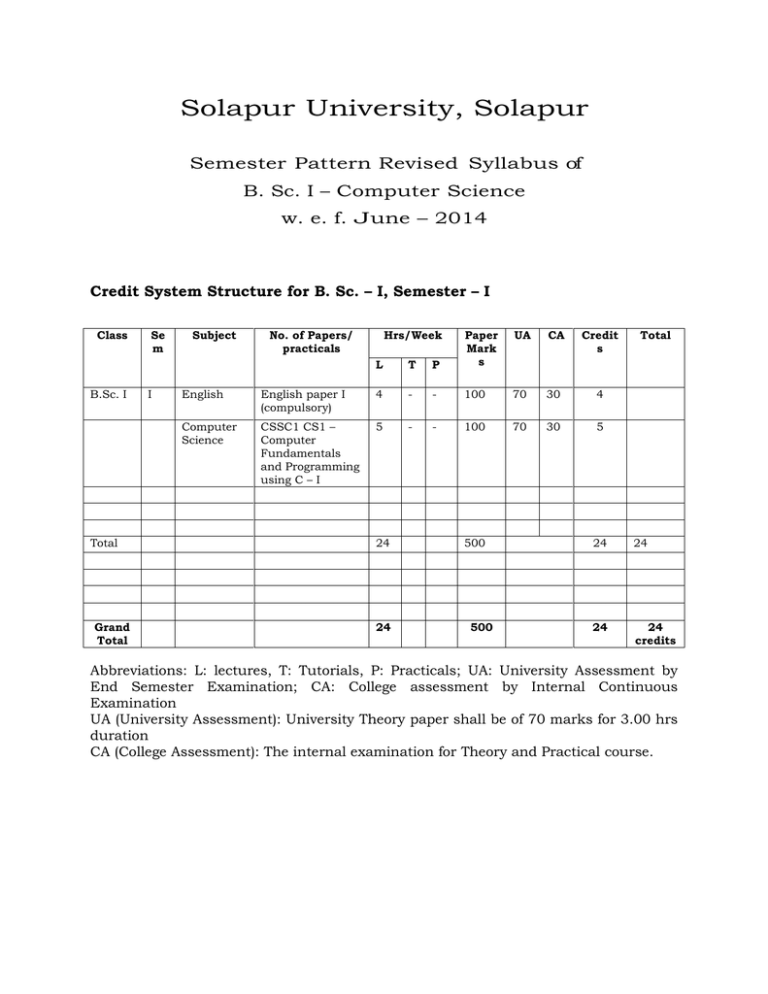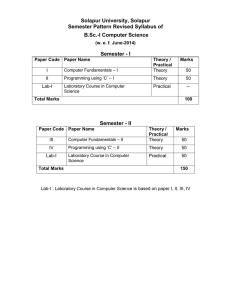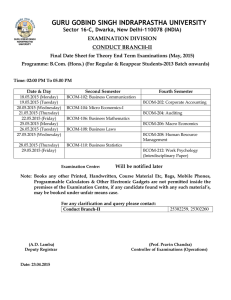Solapur University, Solapur Semester Pattern Revised Syllabus of
advertisement

Solapur University, Solapur Semester Pattern Revised Syllabus of B. Sc. I – Computer Science w. e. f. June – 2014 Credit System Structure for B. Sc. – I, Semester – I Class B.Sc. I Total Grand Total Se m I Subject No. of Papers/ practicals Hrs/Week L T P Paper Mark s UA CA Credit s English English paper I (compulsory) 4 - - 100 70 30 4 Computer Science CSSC1 CS1 – Computer Fundamentals and Programming using C – I 5 - - 100 70 30 5 24 24 500 500 Total 24 24 24 24 credits Abbreviations: L: lectures, T: Tutorials, P: Practicals; UA: University Assessment by End Semester Examination; CA: College assessment by Internal Continuous Examination UA (University Assessment): University Theory paper shall be of 70 marks for 3.00 hrs duration CA (College Assessment): The internal examination for Theory and Practical course. Solapur University, Solapur Faculty of Science Credit System Structure for B. Sc. – I, Semester – II Class B.Sc. I Se m II Subject English Computer Science No. of Papers/ Practicals English paper II (compulsory) CSSC2 CS2 – Computer Fundamentals and Programming using C – II Total Computer Science Total Grand Total B.Sc. CSSC CSPR – Lab – I Hrs/Week L T P 4 - - Pape r Mark s 100 5 - - 100 24 - - 4 24 Par tI 16 UA 70 C A 30 70 30 Pract ical Mark s Credit s UA CA 4 100 70 30 5 500 400 24 4 500 400 900 16 40 1400 24+40 =64 Abbreviations: L: lectures, T: Tutorials, P: Practicals; UA: University Assessment by End semester Examination; CA: College assessment by Internal Continuous Examination UA (University Assessment): University Theory paper shall be of 70 marks for 3.00 hrs duration CA (College Assessment): The internal examination for theory and Practical course. LAB-I: Laboratory Course in Computer Science is based on papers CSSC1 CS1 and CSSC2 CS2 B. Sc. – I: Semester – I I: Computer Fundamentals and Programming using C – I 75 contact hours, 5 credits Section – I Unit 1 [15] Introduction to computer: Definition of computer, characteristics, limitations, concepts of h/w and s/w, capabilities of computers, evaluation, generation, classification based on size and purpose, applications of computers in various fields, computer language – high level, low level, assembly level, compiler, interpreter. Structure of computer: Block diagram, ALU, Memory Unit, Control Unit, Introduction to motherboard, SMPS, Expansion Slots, Serial and Parallel ports. Computer codes and Number System: BCD, EBCDIC, ASCII, Bit, Byte, Word, Number System – Binary, Octal, Decimal, Hexadecimal, Conversion of Number System, Binary Arithmetic – addition, subtraction, multiplication, division, one’s and two’s compliment. Unit 2 [15] Input Devices: Keyboard, Mouse, Light pen, Joystick, Touch screen, Digitizer, Scanner, MICR, OMR, Barcode reader. Output devices: VDU, Printers – Dot-matrix, Inkjet, Laser, Line, Plotters. Concept of Memory: Primary Memory – RAM, ROM, EPROM, PROM. Secondary Storage devices: Magnetic disk, Magnetic tape, Floppy disk, CD ROM Unit 3 [07] Overview of Operating System: Definition and Functions of O.S. Features of O.S., Disk Operating System (DOS), Dos internal and external commands, Batch files commands, concept of directory and file, Types of O.S. – Single user, Multi-user. Section – II Unit 4 [08] Programming Methodology: Step involving in problem solving, Problem definition, Algorithm, Characteristics, Notation of Algorithm, Flowcharts - Definition, Symbol, features, Running and debugging the program. Introduction to C: History, Character set and keywords, Structure of C programming, Constant and its type, Variable and its type (Data types) Unit 5 [15] Operators: Arithmetic, logical, relational, bitwise, increment, decrement, Conditional. Control Statements: Conditional control statements - if, if else, nested if, switch, Looping – for statements, nested for, while, do-while statements, Unconditional control statements - break, continue, goto. Unit 6 [15] Arrays: Array definition and declaration, Single and multidimensional array, basic matrix operations, Character array (string) - Declaration, operation on string and inbuilt String functions. Reference Books 1. Computer Today – Basandra 2. Fundamental of computers – V. Raja Raman. 3. Computer Fundaments – P. K. Sinha. 4. HTML, DHTML, JAVA Script, CGI, Perl – Ivan Bayross 5. Let us C- Y. C. Kanetkar 6. ‘C’ programming- Dennis Ritchie 7. Programming in C- Gottfried 8. Programming in ANSII-C – Balgurusamy B. Sc. – I: Semester – II II: Computer Fundamentals and Programming using C – II 75 contact hours, 5 credits Section – I Unit 1 [15] Windows Operating System: Features of Windows O.S., GUI, Modules of Windows – Windows Explorer, Program manager, Control panel, Printer Manger. Elements of windows – Desktop, Application, icons etc, Windows accessories – Paintbrush, Notepad. Process Management: Multiprogramming, Multitasking, Multiprocessing, Time sharing Networking Environment: Definition of networking, Types of networking – LAN, MAN, WAN Introduction to Internet, Uses and benefits. Unit 2 [15] Editors and Word Processors: Definition of Word Processor, Detail study of features of MS- WORD and MS-EXCEL. Unit 3 [08] Web Technology: Evaluation of internet, HTML, History, Structure of HTML, Tags, Formatting, Text, Adding images, Hyper link, Image Map, Tables, Frames, Sending Email, Introduction to JavaScript, Data types and variables, Operators, control statements, built in functions. Section – II Unit 4 [07] Functions: Definition, declaration, function prototypes, Local and global variables, User defined functions, Storage classes. Unit 5 [15] Pointers: Definition and declaration, Operation on pointer, Pointer initialization, Pointer and function, Pointer and array, Pointer of pointer, Call by value and Call by reference, Dynamic memory allocation, Structures and Union: Definition and declaration, Array of structures, Passing structure to function, Pointer to structure, Nested structure, self referential structure, Size of and type def. Unit 6 [15] File Handling: Standard input - getchar(), getch(), getche(), Standard output putchar(), putch(), putche(), Formatted input - scanf(), sscanf(), fsclose(), File opening mode - open, modify, write, append, Text and binary mode. Macros and Preprocessing: Features of C preprocessor, Macro – Declaration, Expansion, File Inclusion. Reference Books 1. Computer Today – Basandra 2. Fundamental of computers – V. Raja Raman. 3. Computer Fundaments – P. K. Sinha. 4. 5. 6. 7. 8. HTML, DHTML, JAVA Script, CGI, Perl – Ivan Bayross Let us C- Y. C. Kanetkar ‘C’ programming- Dennis Ritchie Programming in C- Gottfried Programming in ANSII-C – Balgurusamy Laboratory course in Computer Science Lab I: 1. 2. 3. 4. 5. Laboratory course – I Demonstration of peripherals. Linking of various peripherals. Operation of all keys of keyboard. DOS – external and internal commands, batch files commands. Windows Operating System – Windows explorer, program manger, control panel, print manager, Creating folders, files, icons, shortcuts. 6. MS – WORD – Creating new documents, typing, deleting, selecting text, undo, Redo, formatting text – auto format, formatting characters, drop caps, Paragraphs, line spacing, margins, page setup, headers and footers, Writer’s tools – spelling checker, auto format, auto correct, find and replace, Mail merge – Data source, Main document, creating mail merge document. 7. MS – EXCEL - Creating worksheet, Graphs, resizing graphs, formulas, if Statement, types of functions. 8. Internet – creating e – mail accounts, browsing. 9. Design HTML page to display student Information. 10. Solve Following program using JAVA Script. a) Check whether given number is even or odd. b) Check whether given number is Prime or not. c) Check whether given number is palindrome or not. d) Check whether given number is perfect or not. Lab I: Laboratory course – II 1. Write a Program to convert the Temperature in centigrade degree to the Fahrenheit degree. 2. Check whether given number is even or odd. 3. Write a program to find out First Fifty Prime numbers. 4. Write a program to find GCD & LCM of given number. 5. Write a program to convert given Binary number into its Octal / Decimal, Hexadecimal Equivalent. 6. Write a program to display Fibonacci series. 7. Write a Recursive function to find out the Factorial of Given Number. 8. Write a program to remove blank lines from a file. 9. Write a program to count the no. of words in a given text file. 10. Write a program to reverse the given number. 11. Write a program to calculate Matrix Addition, Multiplication using Functions as well as without Functioning. 12. Write a program to find given string is Palindrome or not using function. 13. Write a program that accepts the Roll No, Name, Marks obtained in three tests of ‘N’ students & display the total and Average in tabular format. 14. Write a program to accepts two alphabets and pass them to the Function via Pointers which checks for type of these alphabets. If both alphabets are Vowels then function should return to the calling function, their previous alphabets. If both alphabets are Constant then function should return their successor alphabets. 15. Write a program to add two Matrices; Use two Dimensional array as Pointer & Dynamic Memory allocation. 16. Write a program to input 10 names each of the length at least 8 characters sort them in a alphabetical order. 17. Write a program to demonstrate macro substitution. 18. Write a program to demonstrate file inclusion mechanism. Practical Examination for B.Sc. – I will be conducted at the end of semester II


